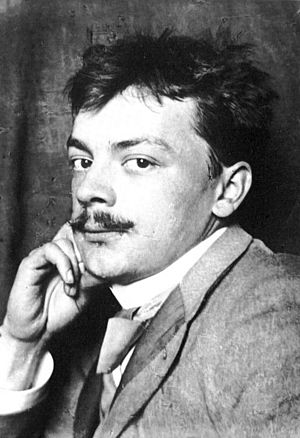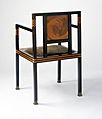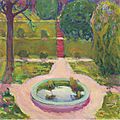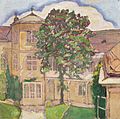Koloman Moser facts for kids
Quick facts for kids
Koloman Moser
|
|
|---|---|

Photograph of Koloman Moser (1905)
|
|
| Born | 30 March 1868 |
| Died | 18 October 1918 (aged 50) Vienna, Austria-Hungary
|
| Education | 1885–1892 Academy of Fine Arts Vienna 1893–1895 Vienna School of Applied Arts (Kunstgewerbeschule) |
| Known for | Painting, Drawing, Postage Stamp, Printmaking, Ceramics, Stained glass |
|
Notable work
|
founder of the Wiener Werkstätte, Stained glass of Kirche am Steinhof |
| Movement | Vienna Secession, Jugendstil |
Koloman Moser (German: [ˈkoːloman ˈmoːzɐ]; 30 March 1868 – 18 October 1918) was an important Austrian artist. He greatly influenced graphic art in the 20th century.
Moser was a leading artist of the Vienna Secession movement. He also helped start a famous design workshop called Wiener Werkstätte.
Moser designed many different kinds of art. These included books and graphic works like postage stamps. He also created fashion, stained glass windows, and items made from porcelain and ceramics. His work included blown glass, tableware, silver, jewelry, and furniture.
Contents
About Koloman Moser
Early Life and Education
Koloman Moser was born in Vienna, Austria, in 1868. His parents were Josef and Thresia Moser. He was the oldest of three children.
He studied art at the Vienna Academy. He also attended the Vienna School of Applied Arts. Later, starting in 1899, he taught art at the Vienna School of Applied Arts.
Artistic Style and Designs
Moser's designs helped define the art style of his time. He worked in architecture, furniture, jewelry, graphics, and tapestries.
He often used clean lines and repeated patterns. These ideas came from classical Greek and Roman art. His style was a reaction against the fancy Baroque art popular in Vienna at the time.
In 1901 and 1902, he published a collection called Die Quelle ("The Source"). This book showed elegant graphic designs for things like tapestries, fabrics, and wallpaper.
Founding the Wiener Werkstätte
In 1903, Moser and his friend Josef Hoffmann started the Wiener Werkstätte. This was a workshop where artists and craftspeople created beautiful and useful household items. They made glassware, silverware, rugs, and textiles.
In 1904, Moser designed the Apse mosaic and glass windows for the Kirche am Steinhof in Vienna. He also designed decorations for the Medallion House. This was part of the Linke Wienzeile Buildings by architect Otto Wagner.
Later Years and Legacy
In 1905, Moser and the Klimt group left the Vienna Secession. In the same year, he married Editha (Ditha) Mautner von Markhof. She was also an artist.
Moser left the Wiener Werkstätte in 1907. This was due to disagreements and financial problems.
Koloman Moser became ill and passed away on October 18, 1918. He was buried three days later in the Hietzing Cemetery.
Moser's Impact and Recognition
Moser was one of the main designers for Austria's leading art magazine, Ver Sacrum. This magazine focused a lot on design. Moser, Gustav Klimt, and Josef Hoffmann were its main designers.
One of Moser's most famous designs is in the Steinhof Church. This design was chosen for a special euro coin. The Austrian 100 euro Steinhof Church commemorative coin was made on November 9, 2005.
On the back of the coin, you can see Koloman Moser's stained glass window. This window is above the main entrance of the church. In the middle of the window, God the Father is shown sitting on a throne. Bronze angels in the Jugendstil style flank the window. These angels were originally designed by Othmar Schimkowitz.
In 2010, one of Moser's design books, "Die Quelle," was sold at auction. It was the third volume in a three-part series. It contained 30 beautiful designs for flat surfaces like tapestries and wallpaper. Each page had a color design on one side and a black-and-white design on the other. It sold for a record price of $12,600.
To mark 100 years since his death, the Museum of Applied Arts Vienna (MAK) held a large exhibition. This show, from December 19, 2018, to April 22, 2019, featured many of Moser's works.
Gallery
See also
 In Spanish: Koloman Moser para niños
In Spanish: Koloman Moser para niños












